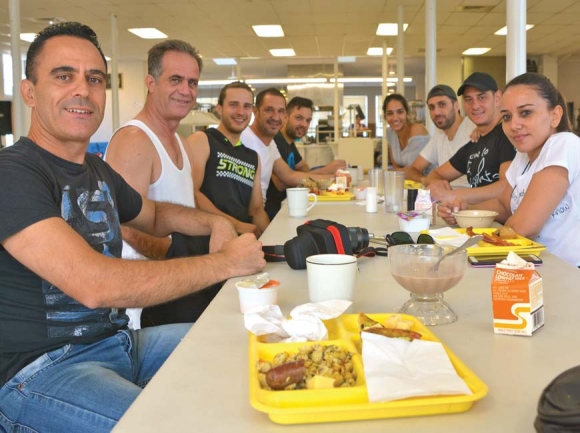Cooperation in a cultural crossroads: Christians, Muslims tear down walls in Cyprus
 Members of the Kyrenia Youth Centre Association enjoy breakfast at Folkmoot July 23. Cory Vaillancourt photo
Members of the Kyrenia Youth Centre Association enjoy breakfast at Folkmoot July 23. Cory Vaillancourt photo
Among the groups visiting this year’s Folkmoot Festival from other countries is one from a place that isn’t quite a country, but is perhaps a historical microcosm of current geopolitical and spiritual conflict between East and West.
“It’s mostly sunny weather, two or three months we live in winter, the rest of the year, around 30 or 40 Celsius degrees,” said Burcin Ozqus, a performer with Kyrenia Youth Centre Association. “It’s green most all the time of the year.”
Less than 50 miles south of Turkey and 70 miles west of Syria sits Cyprus, the third largest island in the Mediterranean Sea.
Now home to more than 1.1 million people, Cyprus has since antiquity been within easy reach of the seafaring peoples of the region, including the Assyrians, Mycenaeans and Persians — all of whom at one point ruled the Connecticut-sized domain.
The Ottoman Empire provided perhaps the most enduring presence on the island, ruling it for more than 300 years until it was placed under British control in 1878.
Greek influence grew during this time, until the majority-Greek population began to agitate for a closer association with Greece in the 1950s, something about 20 percent of the population — Turkic peoples, in the north — resisted.
Related Items
“The culture is the same, but the religion is different. Everything else is the same. We are all Muslims and they are all Christians, Catholics or Orthodox,” said Asena Cin, also a performer with the group. “We live in the north part, which is the Turkish part.”
During the post-colonialist independence movements that began across the world shortly after World War II, Cyprus was among the first to gain independence, in 1960, and like many similar countries saw a period of instability.
“Up to the last 40 years, they were living together, side by side,” said Ozqus. “But something happened.”
A 1974 coup and a pair of subsequent invasions by both the Greeks and the Turks, who captured and occupied about 35 percent of the island’s northern and eastern territory, led to the creation of a UN-mandated buffer zone — a wall, right through the heart of the capital, Nicosia.
Most of the international community still considers Northern Cyprus, which unilaterally declared statehood in 1983, as Turkish-occupied territory of the Republic of Cyprus, but in 2003 Northern Cyprus also unilaterally eased travel restrictions between the two regions, for the first time in three decades.
“When the gates opened in 2003, they wondered, ‘What has happened? What can we do? How can we act?’” he said. “There’s nothing changing badly. There’s not any criminal things from opening the gates. It’s two good things for two sides.”
That wall, which ran right down the middle of a street, was torn down in 2008.
“There’s a border with gates, but nowadays it’s just a sign,” Ozqus said. “We can pass through by walking or bike or car. And the communication is cool between the two sides.”
Formal reunification talks began in 2015 and have a long way to go, but are still a sea change from the state of relations just 10 years ago.
“Day by day, the two sides are relaxed to moving or talking, sitting and talking about the future and the past. And it’s nice,” he said. “We don’t feel bad things about that.”









